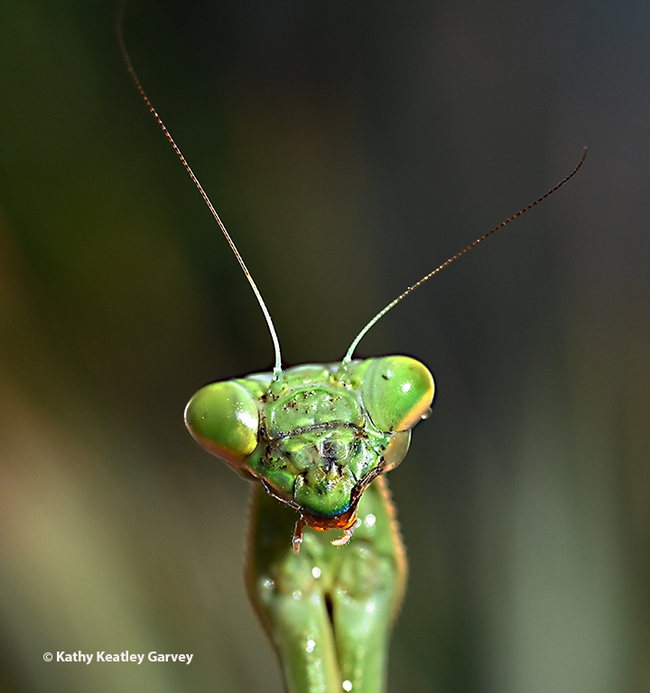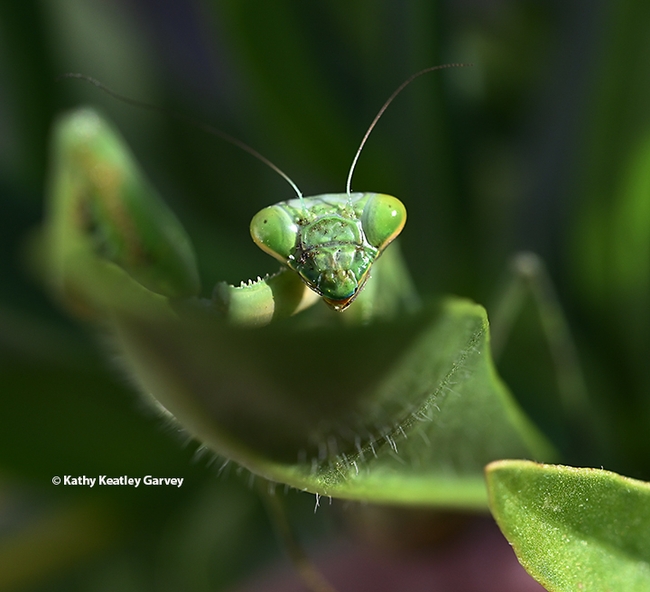- Author: Kathy Keatley Garvey
Date: Sept. 9, 2023
Location: A flower bed in Vacaville, Calif.
Mantis: “Hi, it's me, your favorite praying mantis! I just popped in to say hello!”
Photographer: “Well, hello there, Ms. Stagmomantis limbata, but I think you have ulterior motives! You're not here to greet me and tell me to have a nice day, are you?”
Mantis: “What makes ya think that?”
Photographer: “Because you're hungry and you're an ambush predator and you're waiting to nail an unsuspecting bee or butterfly. But that's OK. Every living thing in this garden eats.”
Mantis: “Ya think?”
Photographer: “Sometimes.”
Mantis: “Well, tell me how I look.”
Photographer: “You look like your crept out of the shadows and your head is spinning in space and it somehow got detached from your body. I could ask you what motivational and existential predicaments are playing directive roles on your current behavior patterns, like I ask all my friends, but I won't. Be well.”
Mantis: “Bee? Where? Where?”

- Author: Kathy Keatley Garvey
Can a praying mantis catch a monarch?
Yes, it can. And yes, it does.
It was Sept. 14, 2013. As I approached a Vacaville supermarket, I noticed pink lantana blooming furiously near the entrance, and then, a familiar-looking butterfly quietly sipping nectar.
"Ah, there's a monarch," I observed.
I wasn't the only one watching the monarch.
A female praying mantis, Stagmomantis limbata, was watching it, too.
In a nano-second, it was all over.
A meal for the mantis.
One less monarch to migrate.
Yes, it can. And yes, it does.



- Author: Kathy Keatley Garvey
So there she is, a gnarly-looking praying mantis, the last of the season, and on her last legs. Last spiked forelegs?
From her perch on a cactus in a Vacaville garden, this Stagmomantis limbata is neither praying nor preying. She is staring. She almost resembles a cartoon character with her wide-spaced bulging eyes atop a triangular head and a pencil-thin neck. One antenna up, one trying to stay down.
Ms. Gnarly Mantis doesn't look at all like a skilled ambush predator.
"Hey, there!" I say.
"Hey, there, yourself! Whatcha looking at?"
"You!"
"Whatcha doing?"
"Taking a photo of you!"
This species, native to North America, is also known as a bordered mantis, an Arizona mantis or a New Mexico praying mantis.
I know S. limbata as a garden treasure.
"Females are most often fairly plain green (often with a yellowish abdomen), but sometimes gray, or light brown, with dark spot in middle of the tegmina, which do not completely cover the wide abdomen. Hind wings may be checkered or striped yellow," according to Wikipedia. "Males are slender, long-winged, and variable in color, but most often green and brown with the sides of the folded tegmina green and top brownish (may be solid gray, brown, green, or any combination of these). Abdomen without prominent dark spots on top. The wings are transparent, usually with cloudy brownish spots on outer half."
Ms. Gnarly Mantis hung around for three days and then she vanished. A hungry California scrub jay may have nailed her.
Or maybe not...
But she bequeathed us her ootheca before her last goodbye.

- Author: Kathy Keatley Garvey
Today is Black Friday, a day that marks the beginning of the Christmas shopping season. It's reportedly the busiest shopping day of the year.
But to us, today is Green Friday, in recognition of a female green praying mantis,Stagmomantis limbata.occupying a rib of a tall green cactus in our Vacaville garden. This is not her "busiest shopping day" of the year.
Ms. Mantis is not praying or preying. She is resting. She is clinging to a Pachycereus marginatus, also known as a "Mexican fence post."
She's the last of the season. She's already deposited her egg case, an ootheca, and she's about to expire.
Ms. Mantis peers at me with her super-duper 3-D vision. She can turn her triangular-shaped head 180 degrees. She's an ambush predator and a strikingly fast predator at that. She can nail a bee, fly or butterfly with her spiked forelegs in about 50 to 70 milliseconds.
But not now.
She is resting. She is the last of the season.
It's Green Friday.

- Author: Kathy Keatley Garvey
Human: "It's the end of Daylight Savings Time!"
Praying Mantis: "The end of Daylight Savings Time? Does that mean I have to stop scaring the livin' daylights out of a bee?"
Human: "No, it's when we humans set the clocks forward by one hour in the spring, and then in the fall, we set the clocks back an hour."
Praying Mantis: "So if I catch a bee today at 4 p.m., it's actually 5 p.m."
Human: "Correct."
Praying Mantis: "And if I eat the bee at 4:05, it's actually 5:05 p.m."
Human: "Correct!"
Praying Mantis: "And if I catch another bee at 5:30 p.m., it's actually 6:30 p.m.?"
Human: "Correct again! Go to the head of the class!"
Praying Mantis: "Why do you humans have Daylight Savings Time?"
Human: "To get more daylight in the spring. Did you know that New Zealand entomologist George Hudson first proposed modern Daylight Savings Time, so that after his work shift, he could get more daylight to collect insects?"
Praying Mantis: "He wanted to collect ME?"
Human: "Yes, and other insects. He won the Hector Memorial Medal in 1923 for proposing Daylight Savings Time."
Praying Mantis: "But still, why would I want to get up an hour earlier in the spring? Honey bees don't leave their colony to forage until it's around 55 degrees."
Human: "Haven't you heard? Early to bed and early to rise makes a MANTIS healthy, wealthy and wise!"
Praying Mantis: "Go away before I mistake you for a bee."



